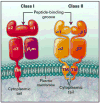Transplantation immunology: solid organ and bone marrow
- PMID: 20176267
- PMCID: PMC2857984
- DOI: 10.1016/j.jaci.2009.11.014
Transplantation immunology: solid organ and bone marrow
Abstract
Development of the field of organ and tissue transplantation has accelerated remarkably since the human MHC was discovered in 1967. Matching of donor and recipient for MHC antigens has been shown to have a significant positive effect on graft acceptance. The roles of the different components of the immune system involved in the tolerance or rejection of grafts and in graft-versus-host disease have been clarified. These components include antibodies, antigen-presenting cells, helper and cytotoxic T-cell subsets, immune cell-surface molecules, signaling mechanisms, and cytokines. The development of pharmacologic and biological agents that interfere with the alloimmune response has had a crucial role in the success of organ transplantation. Combinations of these agents work synergistically, leading to lower doses of immunosuppressive drugs and reduced toxicity. Reports of significant numbers of successful solid-organ transplantations include those of the kidneys, liver, heart, and lung. The use of bone marrow transplantation for hematologic diseases, particularly hematologic malignancies and primary immunodeficiencies, has become the treatment of choice in many of these conditions. Other sources of hematopoietic stem cells are also being used, and diverse immunosuppressive drug regimens of reduced intensity are being proposed to circumvent the mortality associated with the toxicity of these drugs. Gene therapy to correct inherited diseases by means of infusion of gene-modified autologous hematopoietic stem cells has shown efficacy in 2 forms of severe combined immunodeficiency, providing an alternative to allogeneic tissue transplantation.
Copyright 2010 American Academy of Allergy, Asthma & Immunology. Published by Mosby, Inc. All rights reserved.
Figures


References
-
- Bach FH, Amos DB. Hu-1: major histocompatibility locus in man. Science. 1967;156:1506–8. - PubMed
-
- Holdsworth R, Hurley CK, Marsh SG, Lau M, Noreen HJ, Kempenich JH, et al. The HLA dictionary 2008: a summary of HLA-A, -B, -C, -DRB1/3/4/5, and -DQB1 alleles and their association with serologically defined HLA-A, -B, -C, -DR, and -DQ antigens. Tissue Antigens. 2009;73:95–170. - PubMed
-
- Klein J, Sato A. The HLA system: first of two parts. N Engl J Med. 2000;343:702–9. - PubMed
-
- Marsh SG. WHO Nomenclature Committee for Factors of the HLA System. Nomenclature for factors of the HLA system, update June 2009. Tissue Antigens. 2009 Oct;74:364–6. - PubMed
-
- Klein J, Sato A. The HLA system: second of two parts. N Engl J Med. 2000;343:782–6. - PubMed
Publication types
MeSH terms
Substances
Grants and funding
LinkOut - more resources
Full Text Sources
Other Literature Sources
Medical
Research Materials

